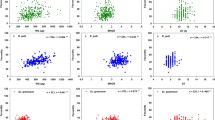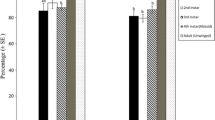Abstract
The need to allocate a limited amount of energy between different life-history traits is a fundamental assumption in life-history theory. However, it has often turned out to be extremely difficult to measure the competing processes that contribute to costs or benefits for individual organisms. The present investigation begins by analysing how an aphid clonal lineage adapts its reproductive investment to moderate changes in host plant quality (e.g. during the life cycle of its host). Using Centaurea jacea and Uroleucon jaceae as a model plantaphid system, I show that reproductive investment can be far more complex than indicated by dry or wet mass of the gonads alone. The number of embryos of a particular size class or developmental state present in the reproductive system of an aphid is highly flexible and is influenced by the quality of the host plant. Next, the effects of a particular reproductive investment on survival during periods of food deprivation are analysed for aphids originating from host-plants of different qualities. When food stress is severe the ability to rapidly resorb and reallocate resources committed to offspring is important for survival. However, this ability is limited. I argue that, in periods of food stress, young, unsclerotized embryos might serve as a kind of energy buffer similar to a fat body and are therefore not relevant to cost-benefit calculations. However, embryos that are beginning to sclerotize within the ovarioles are not available for resorption and resource reallocation. They compete for nutrients with their mother and contribute to costs. Therefore, it is suggested that the reproductive investment of an aphid should not be equated with reproductive costs in a general al way. The dynamics of adaptive resource allocation and resorption are a key feature of an aphid's life history, and the implications for life-history theory are discussed.
Similar content being viewed by others
References
Bell G (1980) The costs of reproduction and their consequences. Am Nat 116:45–76
Bliss M, Kearby WH (1971) Observations on the oviposition sites and laboratory development of the fundatrix and virginopara of the aphid Eulachnus agilis. Ann Ent Soc Am 64:1407–1410
Brough CN, Dixon AFG (1990) Structure of the trophic chamber (germarium) in virginoparae of the vetch aphid, Megoura viciae Buckton (Homoptera: Aphididae). Int J Insect Morphol Embryol 19:155–163
Büning J (1985) Morphology, ultrastructure, and germ cell cluster formation in ovarioles of aphids. J Morphol 186:209–221
Burpree DM, Sakaluk SK (1993) Repeated matings offset costs of reproduction in female crickets. Evol Ecol 7:240–50
Dixon AFG (1987) Parthenogenetic reproduction and the rate of increase in aphids. In: Minks AK, Harrewijn P (eds) Aphids: their biology, natural enemies and control, vol 2A. Elsevier, Amsterdam, pp 269–287
Dixon AFG, Kundu R, Kindlmann P (1993) Reproductive effort and maternal age in iteroparous insects using aphids as a model group. Funct Ecol 7:267–272
El-Kassaby YA, Barclay HJ (1992) Cost of reproduction in Douglas fir. Can J Bot 70:1429–1432
Gustaffson L, Pärt T (1990) Acceleration of senescence in the collared flycatcher Ficedula albicollis by reproductive costs. Nature 347:279–281
Jennings MJ, Philipp DP (1992) Reproductive investment and somatic growth rates in longear sunfish. Environ Biol Fish 35: 257–271
Johnson B (1958) Embryonic cuticle in aphids. Aust J Sci 21: 146–147
Kindlmann P, Dixon AFG (1989) Developmental constraints in the evolution of reproductive strategies: telescoping of generations in parthenogenetic aphids. Funct Ecol 3:531–537
Kobayashi M, Ishikawa H (1993) Breakdown in indirect flight muscle of alate aphids (Acyrthosiphon pisum) in relation to their flight, feeding and reproductive behavior. J Insect Physiol 39:549–554
Lessells CM (1986) Brood size in Canada geese: a manipulation experiment. J Anim Ecol 55:669–689
McCauley E, Murdoch WW, Nisbet RM, Gurney WSC (1990) The physiological ecology of Daphnia: development of a model of growth and reproduction. Ecology 71:703–715
Norušis MJ (1990) SPSS/PC+ for the IBM PC/XT/AT and PS2. Base manual, statistics and advanced statistics. SPSS. Chicago
Pettifor RA, Perrins CM, McCleery RH (1988) Individual optimisation of clutch size in great tits. Nature 336:160–162
Ponsen MB (1992) Structure of the digestive system in aphids. Wageningen Agric Univ Pap 91:1–61
Reznick D (1985) Cost of reproduction: an evaluation of the empirical evidence. Oikos 44:257–267
Reznick D (1992) Measuring the cost of reproduction. Trends Ecol Evol 7:42–45
Roitberg BD (1989) The cost of reproduction in rosehip flies, Rhagoletis basiola: eggs are time. Evol Ecol 3:183–188
Schultz ET, Warner RR (1989) Phenotypic plasticity in life-history traits of female Thalassoma bifasciatum (Pisces: Labridae). 1. Manipulations of social structure in tests for adaptive shifts of life-history allocations. Evolution 43:1497–1506
Schwarzkopf L (1993) Costs of reproduction in water skinks. Ecology 74:1970–1981
Sokal RR, Rohlf FJ (1986) Biometry, 2nd edn Freeman, New York
Stadler B (1992) Physiological responses of Uroleucon jaceae (L.) to seasonal changes in the quality of its host plant Centaurea jacea L.: multilevel control of adaptations to the life cycle of the host. Oecologia 91:273–280
Stadler B, Weisser WW, Houston AI (1994) Defence reactions in aphids: the influence of state and future reproductive success. J Anim Ecol 63:419–430
Stearns SC (1976) Life history tactics: a review of the ideas. Q Rev Biol 51:3–47
Stearns SC (1992) The evolution of life histories. Oxford University Press, Oxford
Syrjänen K, Lehtilä K (1993) The cost of reproduction in Primula veris: differences between two adjacent populations. Oikos 67: 465–72
Walters KFA, Dixon AFG (1983) Migratory urge and reproductive investment in aphids: variation within clones. Oecologia 58: 70–75
Ward SA, Dixon AFG (1982) Selective resorption of aphid embryos and habitat changes relative to life-span. J Anim Ecol 51: 859–864
Ward SA, Wellings PW, Dixon AFG (1983a) The effect of reproductive investment on pre-reproductive mortality in aphids. J Anim Ecol 52:305–313
Ward SA, Dixon AFG, Wellings PW (1983b) The relation between fecundity and reproductive investment in aphids. J Anim Ecol 52:451–461
Williams GC (1966) Natural selection, the costs of reproduction, and a refinement of Lack's principle. Am Nat 100:687–90
Author information
Authors and Affiliations
Rights and permissions
About this article
Cite this article
Stadler, B. Adaptive allocation of resources and life-history trade-offs in aphids relative to plant quality. Oecologia 102, 246–254 (1995). https://doi.org/10.1007/BF00333257
Received:
Accepted:
Issue Date:
DOI: https://doi.org/10.1007/BF00333257




